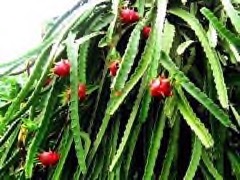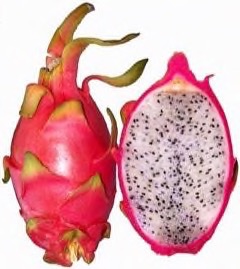 |
|
Bùi Thy Ðào Nguyên wikimedia |
 |
| T.Voekler wikimedia |
Translate this page:
Summary
Other common names include Red Pitaya, Strawberry Pear, Night Blooming Cereus, Queen of the Night, and Honolulu Queen. Hylocereus undatus or commonly known as Dragon Fruit is a climbing cactus or succulent shrub with triangular stalks that can be up to 7 m long. It produces aerial roots enabling it to climb and support itself. It is widely cultivated for its edible fruit with a sweet and pleasant flavor. The fruit is red, 7-12 cm long, and covered in prominent scales. The flowers are white but yellowish-green on the outside and open at night. The plant is also used as an ornamental plant. It is fast growing and can be grown in semi-shade or full sun.
Physical Characteristics

 Hylocereus undatus is an evergreen Shrub growing to 4 m (13ft) by 2 m (6ft) at a fast rate.
Hylocereus undatus is an evergreen Shrub growing to 4 m (13ft) by 2 m (6ft) at a fast rate.
See above for USDA hardiness. It is hardy to UK zone 10. The flowers are pollinated by Bats. The plant is self-fertile.
It is noted for attracting wildlife.
Suitable for: light (sandy), medium (loamy) and heavy (clay) soils, prefers well-drained soil and can grow in nutritionally poor soil. Suitable pH: mildly acid and neutral soils and can grow in very acid soils.
It can grow in semi-shade (light woodland) or no shade. It prefers dry or moist soil and can tolerate drought.
UK Hardiness Map
US Hardiness Map
Synonyms
Cereus tricostatus Gosselin Cereus undatus Haw. Hylocereus guatemalensis (Weing.) Britton & Rose Hyl
Plant Habitats
Edible Uses
Fruit - raw or cooked[335 ]. Delicious[317 ]. A sweet, pleasant flavour[335 ]. The red fruit is 7 - 12cm long, covered in prominent scales[335 ]. Unopened flower buds can be cooked and eaten as a vegetable[377 ].
References More on Edible Uses
Medicinal Uses
Plants For A Future can not take any responsibility for any adverse effects from the use of plants. Always seek advice from a professional before using a plant medicinally.
None known
References More on Medicinal Uses
The Bookshop: Edible Plant Books
Our Latest books on Perennial Plants For Food Forests and Permaculture Gardens in paperback or digital formats.

Edible Tropical Plants
Food Forest Plants for Hotter Conditions: 250+ Plants For Tropical Food Forests & Permaculture Gardens.
More

Edible Temperate Plants
Plants for Your Food Forest: 500 Plants for Temperate Food Forests & Permaculture Gardens.
More

More Books
PFAF have eight books available in paperback and digital formats. Browse the shop for more information.
Shop Now
Other Uses
Hedge
Agroforestry Uses: This species can be grown as a hedge or trellis plant, providing habitat for wildlife. Its flowers attract pollinators, and the fruit is a valuable food crop. The plant can be used to make a beautiful flowering hedge[317 ]. 1. Nectary - Flowers rich in nectar and pollen:
Yes – The large, night-blooming flowers of dragonfruit are rich in nectar and attract various pollinators, particularly moths and bats.
2. Wildlife - Food (Fruit, Seeds, Leaf litter, Shelter, Nesting, Roosting):
Yes – The fruit is edible and provides food for birds and mammals. The plant can also offer some shelter for small animals due to its sprawling habit.
3. Invertebrate Shelter (Overwintering sites, Leaf litter, Groundcover):
Yes – The structure of the plant can provide shelter for invertebrates, and leaf litter may serve as a habitat for beneficial insects.
4. Pest Confuser (Smell):
No – While the flowers have a pleasant scent, they are not specifically known to confuse or deter pests.
Special Uses
Food Forest Hedge
References More on Other Uses
Cultivation details
A plant of the warm tropical lowlands with low to high rainfall[335 ]. It grows best in areas where annual daytime temperatures are within the range 18 - 28c, but can tolerate 12 - 34c[418 ]. It succeeds with a mean annual rainfall in the range 300 - 3,500mm[418 ]. Often an epiphytic plant, though it also grows on the ground. Requires a well-drained soil and a pH of 6 or lower[200 ]. Prefers a pH in the range 5.3 - 6.7, tolerating 5 - 7.5[418 ]. Widely cultivated in the tropics and subtropics, it has often escaped from cultivation and become naturalised. It has been classified as 'invasive' in some areas, where it often spreads vegetatively[305 ]. Plants grow well, but do not always set fruit well, when growing in the wetter areas of the tropics[377 ]. They can have 4-6 fruiting cycles per year. Flowering Time: Late Summer/Early Fall. Bloom Color: Green White/Near White. Spacing: 12-15 in. (30-38 cm). The fruit is usually harvested in late summer to autumn, approximately 30 to 50 days after flowering.
Dragonfruit is a relatively fast-growing cactus, often producing fruit within 1 to 3 years after planting, depending on growing conditions.
Hylocereus typically flowers in late spring to early summer. Hylocereus undatus is typically self-fertile but can benefit from cross-pollination for better fruit set.
References Carbon Farming Information and Carbon Sequestration Information
Temperature Converter
Type a value in the Celsius field to convert the value to Fahrenheit:
Fahrenheit:
The PFAF Bookshop
Plants For A Future have a number of books available in paperback and digital form. Book titles include Edible Plants, Edible Perennials, Edible Trees,Edible Shrubs, Woodland Gardening, and Temperate Food Forest Plants. Our new book is Food Forest Plants For Hotter Conditions (Tropical and Sub-Tropical).
Shop Now
Plant Propagation
Seed - Stem cuttings. The cuttings are usually dried out for a week or two. The plants are self sterile and have to be pollinated by bats and moths. Hand pollination is recommended for good fruit production.
Other Names
If available other names are mentioned here
Dragon Fruit, Red Pitaya, Strawberry Pear, Night blooming Cereus, Queen of the Night, Honolulu Queen, Chacam, Chak-wob, Flor de caliz, Junco tapatio, Night blooming cereus, Pitahaya, Pitaia-branca, Pitaia-vermelha, Pitaya orejona, Pitaya, Pratiel puehs, Queen of the night, Reina de la noche, Strawberry pear, Tasajo, Thang loy, Zacamb,
Native Range
SOUTHERN AMERICA: El Salvador, Guatemala, Honduras, Mexico Central, Mexico Gulf, Mexico Northeast, Mexico Southeast, Mexico Southwest,
Weed Potential
Right plant wrong place. We are currently updating this section.
Please note that a plant may be invasive in one area but may not in your area so it's worth checking.
Conservation Status
IUCN Red List of Threatened Plants Status : Status: Data Deficient

Growth: S = slow M = medium F = fast. Soil: L = light (sandy) M = medium H = heavy (clay). pH: A = acid N = neutral B = basic (alkaline). Shade: F = full shade S = semi-shade N = no shade. Moisture: D = dry M = Moist We = wet Wa = water.
Now available:
Food Forest Plants for Mediterranean Conditions
350+ Perennial Plants For Mediterranean and Drier Food Forests and Permaculture Gardens.
[Paperback and eBook]
This is the third in Plants For A Future's series of plant guides for food forests tailored to
specific climate zones. Following volumes on temperate and tropical ecosystems, this book focuses
on species suited to Mediterranean conditions—regions with hot, dry summers and cool, wet winters,
often facing the added challenge of climate change.
Read More
Expert comment
Author
(Haw.) Britton & Rose
Botanical References
1
Links / References
For a list of references used on this page please go here
A special thanks to Ken Fern for some of the information used on this page.
Readers comment
| Add a comment |
|
If you have important information about this plant that may help other users please add a comment or link below. Only comments or links that are felt to be directly relevant to a plant will be included. If you think a comment/link or information contained on this page is inaccurate or misleading we would welcome your feedback at [email protected]. If you have questions about a plant please use the Forum on this website as we do not have the resources to answer questions ourselves.
* Please note: the comments by website users are not necessarily those held by PFAF and may give misleading or inaccurate information.
To leave a comment please Register or login here All comments need to be approved so will not appear immediately.
|
Subject : Hylocereus undatus
|
|
|
|